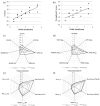Personalized Tests in Paralympic Athletes: Aerobic and Anaerobic Performance Profile of Elite Wheelchair Rugby Players
- PMID: 32916810
- PMCID: PMC7563775
- DOI: 10.3390/jpm10030118
Personalized Tests in Paralympic Athletes: Aerobic and Anaerobic Performance Profile of Elite Wheelchair Rugby Players
Abstract
In Paralympic sports, the goal of functional classifications is to minimize the impact of impairment on the outcome of the competition. The present cross-sectional study aimed to investigate aerobic and anaerobic personalized tests in Paralympic athletes and to correlate them with the classification of the international wheelchair rugby federation (IWRF). Sixteen elite players of the Italian wheelchair rugby team volunteered for the study. Aerobic (incremental test to exhaustion) and anaerobic (Wingate 30s all-out test, 5 and 10-meter sprint test, shuttle test, isometric test) sport-performance measurements were correlated singularly or grouped (Z scores) with the classification point. Moreover, a multivariate permutation-based ranking analysis investigated possible differences in the overall level of performance among the adjacent classified groups of players, considering the scores of each test. A statistically significant correlation between the performance parameters and the IWRF functional classification considering both aerobic and anaerobic personalized tests was detected (0.58 ≤ r ≤ 0.88; 0.0260 ≤ p ≤ 0.0001). The multivariate permutation-based ranking analysis showed differences only for the low-pointers versus mid-pointers (p = 0.0195) and high-pointers (p = 0.0075). Although single performance parameters correlated with athletes' classification point, results of the multivariate permutation-based ranking analysis seem to suggest considering only the most significant anaerobic and sport-specific performance parameters among athletes. These should be combined with the physical assessment and the qualitative observation, which are already part of the classification process to improve its effectiveness.
Keywords: Wingate test; classification; invasion games; oxygen consumption; sprint test; wheelchair sport.
Conflict of interest statement
The authors declare no conflict of interest.
Figures



Similar articles
-
Laboratory and Non-laboratory Assessment of Anaerobic Performance of Elite Male Wheelchair Basketball Athletes.Front Psychol. 2019 Mar 13;10:514. doi: 10.3389/fpsyg.2019.00514. eCollection 2019. Front Psychol. 2019. PMID: 30930816 Free PMC article.
-
Relationship between aerobic and anaerobic parameters and functional classification in wheelchair basketball players.Scand J Med Sci Sports. 2010 Aug;20(4):638-43. doi: 10.1111/j.1600-0838.2009.00934.x. Epub 2009 May 28. Scand J Med Sci Sports. 2010. PMID: 19793219
-
Spinal Cord Injury Impairs Cardiovascular Capacity in Elite Wheelchair Rugby Athletes.Clin J Sport Med. 2020 Jan;30(1):33-39. doi: 10.1097/JSM.0000000000000561. Clin J Sport Med. 2020. PMID: 31855910
-
Physiology of wheelchair racing in athletes with spinal cord injury.Sports Med. 2002;32(1):23-51. doi: 10.2165/00007256-200232010-00002. Sports Med. 2002. PMID: 11772160 Review.
-
Field-based physiological testing of wheelchair athletes.Sports Med. 2013 Feb;43(2):77-91. doi: 10.1007/s40279-012-0009-6. Sports Med. 2013. PMID: 23329608 Review.
Cited by
-
Trying to use temporal and kinematic parameters for the classification in wheelchair badminton.PLoS One. 2025 Mar 28;20(3):e0315939. doi: 10.1371/journal.pone.0315939. eCollection 2025. PLoS One. 2025. PMID: 40153392 Free PMC article.
-
Assessment of muscle strength in para-athletes: A systematic review of observational studies.Sports Med Health Sci. 2022 Aug 29;4(4):225-238. doi: 10.1016/j.smhs.2022.07.004. eCollection 2022 Dec. Sports Med Health Sci. 2022. PMID: 36600967 Free PMC article. Review.
-
Evaluation of a standardized test protocol to measure wheelchair-specific anaerobic and aerobic exercise capacity in healthy novices on an instrumented roller ergometer.PLoS One. 2022 Sep 6;17(9):e0274255. doi: 10.1371/journal.pone.0274255. eCollection 2022. PLoS One. 2022. PMID: 36067184 Free PMC article.
-
Impact of floor covering on wheelchair rugby players: analysis of rolling performance.Front Sports Act Living. 2024 Jan 4;5:1283035. doi: 10.3389/fspor.2023.1283035. eCollection 2023. Front Sports Act Living. 2024. PMID: 38239893 Free PMC article.
References
-
- IWRF International Wheelchair Rugby Federation. [(accessed on 26 August 2020)]; Available online: https://www.iwrf.com.
-
- Hart A., Altmann V., Ungerer G., Stodler J. International Wheelchair Rugby Federation (iwrf) Classification Manual. 3rd ed. IWRF; Delta, BC, Canada: 2015.
Grants and funding
LinkOut - more resources
Full Text Sources

